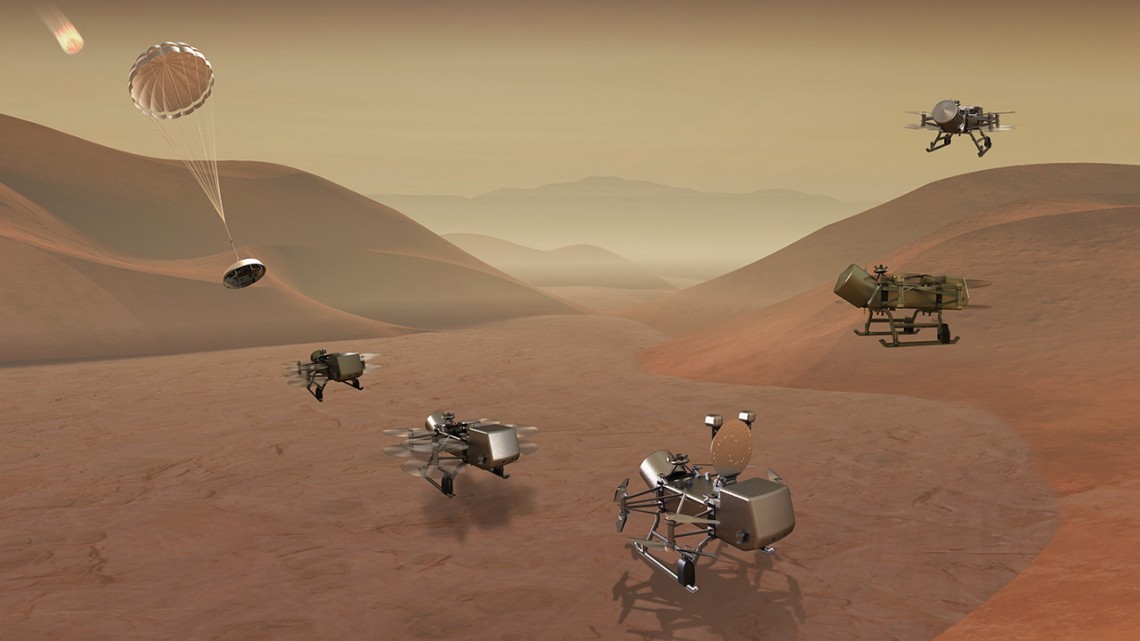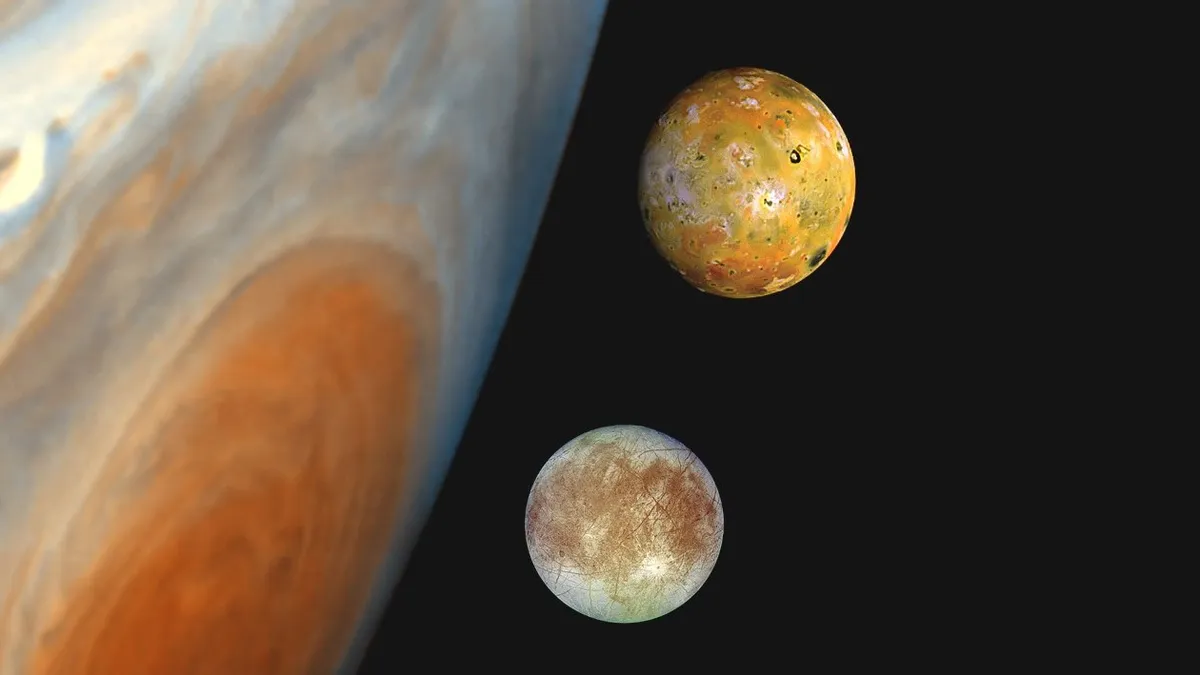-
Dragonfly: Quadcopter on Titan
After the recent rocket launch in preparation for the Artemis mission, I decided to look into the other space exploration projects currently underway. One that stuck out to me is the Dragonfly mission. After the landing of Huygens, a space probe sent from Cassini, in 2005, astronomers have desired a more advanced exploration of Titan. Evidence currently points to a subterranean ocean existing below the surface, and this could have huge implications for the survival of humans elsewhere in the solar system. Titan also has dunes, mountains, lakes, and rivers that are methane based instead of water. Study of these features could tell us about non-water based geological processes. Titan’s current atmosphere also resembles Earth’s early atmosphere which could help us better understand Earth’s development.
Dragonfly is unique compared to other rovers because it is actually a quadcopter. Because Titan’s atmosphere is about 50% denser than Earth’s meaning it is dense enough for flight (unlike Mars) but not so dense it will crush the rover. The low gravity also means flight is more fuel efficient than on Earth. This means Dragonfly will explore an area of Titan and fly up to 10 kilometers to the next site to collect more data. The battery will then charge over the course of one Titan day (16 Earth days) to gain enough power for the next flight. After this mission we will have a thorough map of some of Titan’s surface including areas not easily accessible with a land rover like mountains. Learn more about Dragonfly here.

Source: NASA/JOHNS HOPKINS APL/STEVE GRIBBEN/MAGDA SAINA The current launch window is scheduled for June 2027 with an arrival to Titan in 2034. Although this is still far out, I am excited for the new information we will gain about Titan, Earth, and the development of quadcopter based rovers.
-
Could We Even Communicate With Aliens If We Found Them?
After learning about the Golden Record, Arecibo message, and other ways astronomers have attempted to communicate with extraterrestrial life (if it is out there), I can’t help but think this outreach is very limited to civilizations that communicate in exactly the same way as we do. This seems unlikely to me, given the extreme diversity in communication of species limited to Earth. For example, octopuses, which are widely considered one of the most intelligent animal species, communicate through gestures and changing skin color. Others communicate through smells, dances, calls, and more that we cannot even decipher. Even as humans, we speak in a very limited range of frequencies, and our written language is completely arbitrary to our own cultures.
The odds of an alien species existing, wanting to contact us, and then being able to understand us are incredibly slim. Again the analogy of an alien species wanting to communicate with ants (us) rings true. Then, assuming we found a way to communicate, our understanding of the universe through math and physics might be completely foreign to them. This reminds me of the movie Arrival where ideas such as quantum physics and string theory are incredibly simple, but our concepts of basic math like addition and algebra are very difficult. Although this situation is not super scientific, and the movie takes a lot of creative liberties, it does provoke thought about communication with extraterrestrials. Perhaps the probability to have the ability to communicate in a similar and meaningful way with other possible civilizations should be another variable in the Drake or Seager Equations.
Alien communication from Arrival. Source: Paramount Pictures Some astronomers are currently working on ways to make communication with extraterrestrials possible, and it revolves largely around AI. Machine learning techniques are already being implemented at the University of Toronto to sift through data collected over the past several years and determine whether we missed evidence of extraterrestrial communication. The AI has already output 8 “signals of interest” based on its initial algorithm, and through fine tuning the algorithm, the AI should only become more accurate. Learn more about this research here.
As we have all seen the rise of AI in recent months, perhaps it is the key to not only recognizing extraterrestrial communication but also work as a sort of translator between civilizations. After recognizing patterns in the other civilizations’ communication, it could likely come up with translation for humans to understand. Or another possibility is that the AI becomes so much more intelligent than us that this alien civilization decides it is worth communicating with the AI instead of us.
Much is yet to be seen, but the rapid and continuing development of AI could be the key in the search for and eventual communication with extraterrestrial life.
-
Ceres, the Celebrity of the Asteroid Belt
Despite comprising almost a third of the asteroid belt’s total mass, Ceres is often left out of dwarf planet discussions. However, Ceres is actually pretty unique and could potentially support life in the future. Because of its relative closeness compared to the likes of Pluto, it was the first dwarf planet to be visited by a spacecraft, called Dawn. While Ceres looks like many asteroids, especially those called C-type asteroids, Ceres contains much more water than anticipated. In fact, it could possibly be almost 25% water, which is more than available on Earth. It also contains ammonia on its surface which is characteristic of objects outside of the ice line. In these ways, Ceres is much more similar to a Kuiper Belt object than an asteroid belt one. There are plenty of theories suggested to explain how these characteristics formed in the asteroid belt, but some scientists believe Ceres actually originated outside the orbit of Saturn. During the early solar system formation, it could have migrated to its current location as giant planets shifted. Learn more about the migration theory here.
Another unique factor separating Ceres from other asteroids is evidence that Ceres was geologically active despite its small size. Ceres could not generate heat like other terrestrial planets or through tidal friction like many giant moons. Instead, it is thought that Ceres was initially cold, and the radioactive decay of elements like uranium and thorium heated the planet up for a period of time before cooling again. This process is called radiogenic heating, and its natural instability would produce unique features across the surface of Ceres. For example, there is a large plateau on one hemisphere with localized fractures that were lacking on the other hemisphere. Physicists simulated this with a model of localized instability on one hemisphere, and the fractures match those observed by the Dawn spacecraft. Read more about the model here.
This geological activity could have created ice volcanoes which could produce the water vapor found in its thin atmosphere. Additionally, layers of ice could shift and erase large craters while perhaps even a layer of water ice exists below the crust. Because of this, some astronomers are hoping for a rover mission to Ceres to take samples and gather information about the possibility of sustaining life not so far away from home.
An artist’s rendition of Cere’s possible layers is shown below.

Source: NASA/JPL-Caltech/UCLA/MPS/DLR/IDA -
Water Beads on the Moon
After analyzing Moon samples taken over two years ago, scientists have discovered glass beads of water on the surface of the Moon. The Chinese probe, Chang’e 5, took soil samples from the lunar surface as part of China’s first sample-return mission. These glass beads are thought to be across the entire surface of the Moon and hold potentially 600 trillion pounds in just the top 40ft of the surface. Although it was widely thought that the Moon contains water, it was previously unknown how much of it still existed.
This discovery also raises the question of how these beads formed, and scientists analyzing the samples have a theory. When asteroids collide with the moon, pieces of the lunar surface are launched into the atmosphere and heated. Under these intense circumstances, silicate particles from the asteroids combine to create tiny glass beads. Water is thought to have formed in the beads through interactions with solar wind. Hydrogen atoms, which match the type released from the Sun, combine with oxygen in the beads to form water molecules. These beads can then release water back into the surface.
This suggests that the moon has an active water cycle and vast amounts of water stored under the surface. Possibly in the future with more lunar explorations and missions, water will not have to be transported. Water weighs over 8 pounds to the gallon which makes it particularly expensive rocket cargo and often the limiting factor for manned missions. Lunar exploration or settlement could be sustainable, and future explorers could possibly extract the water, use it, and recycle it, without needing shipments from Earth. Read more about the finding here.

Glass beads from a lunar sample. Source: Beijing SHRIMP Center, Institute of Geology, Chinese Academy of Geological Sciences Would you want to try a glass of water from the Moon?
-
James Webb Space Telescope Discovers “Impossible” Galaxies
I’m sure many of you are familiar with the James Webb Space Telescope: the successor to the Hubble Telescope and most powerful space telescope built to date. It was launched into space a little more than one year ago with the goal of observing the first galaxies and investigating our cosmic origin. In this short period of time new groundbreaking discoveries seem to appear every few weeks, but a particularly interesting observation was made about a week ago.
For some context, most galaxies are approximately 10 to 13.6 billion years old, and our own Milky Way is 13.61 billion years old. These ages are representative of the oldest parts of each galaxy, not all parts of the galaxy as a whole. Compared to the estimated age of the universe at 13.8 billion years, the oldest galaxies only started forming a few hundred million years after the Big Bang. New galaxies continue to form billions of years later with the youngest galaxy we have observed being close to 500 million years old (source). All of this is widely accepted by scientists; however, new images from the James Webb Telescope have thrown this into question.
An image (shown below) released by the telescope features a few fuzzy red dots which astronomers believe are six possible galaxies. These galaxies are not the oldest discovered, forming approximately 500 to 700 million years after the Big Bang. Their age is unsurprising, but their red color and immense size is. Based on preliminary calculations, these galaxies are estimated to be on par in mass with the Milky Way–almost 50 times more massive than ever expected, and yet are 13 billion years younger. Forming so many stars that quickly shouldn’t be possible based on the amount of non-dark matter available at that time (source). Combined with the red color which indicates very old stars, these potential galaxies’ appear much older than they should be. From our current understanding of the universe, these galaxies should not exist at all. Before we rewrite widely accepted theories, more research needs to be done on what else the galaxies could be, or what is causing their red color if not old stars. However, it raises lots of questions about our understanding of star formation and the behavior of the early universe.
Do you think we will have to rework our model of early galaxy formation, or is there another explanation? Read more about the discovery here. I also highly recommend looking through the JWST’s library of photos.

Source: James Webb Space Telescope at NASA, ESA, CSA, I. Labbe -
Lack of Cratering: Io and Europa
During class, we have discussed magnetospheres, tectonics, geological activity, and their relation to the cores of the “Big Five”: Earth, Venus, Mercury, the Moon, and Mars. Specifically the moon has very obvious cratering across its entire surface, and its craters remain intact for billions of years. This is due to it not having an atmosphere which contributes to erosion, and most significantly the Moon has a cold, dense core that does not allow for great geological or tectonic activity. When I think of moons in general, I tend to think of all of them having a generally rocking and cratered surface. However, this is not always the case, as is demonstrated by the Galilean Moons.
While Callisto and Ganymede resemble our Moon somewhat in appearance, with visible craters and dark areas–in fact Callisto is one of the most heavily cratered objects in our solar system, Io and Europa look much different.
Io varies greatly in appearance from most other moons due to its yellowish color, surface littered with massive volcanoes, and obvious lack of cratering. Although volcanoes are typically associated with tectonic activity as on Earth, this is likely not the case for Io. Io actually has an elliptical orbit because it is in a constant struggle with the gravitational force provided by Jupiter and the other Galilean Moons, Europa and Ganymede. This causes Io to bulge as it orbits and experience extreme tidal forces. The tides and tidal friction cause Io to generate large amounts of heat (source). This heat radiates outward and fuels the constant volcanic activity on the surface. In turn, this volcanic activity causes the surface to constantly renew itself, explaining its lack of cratering. Although Io likely has an iron core, it does not cause the geological activity on its surface, and might not have a magnetic field at all. More information about Io’s surface can be found here.
Europa, which is a little smaller than our moon, has a very unique appearance with lots of “scratches” and deep cracks running all along its surface, and there are only a few craters. The lack of widespread cratering implies its relative youth (40-90 million years old) and that recent geological activity has removed them (source). Scientists believe underneath the icy crust (about 10-15 miles thick) is an ocean that the surface rests on. The much hotter iron core in its center causes the ice layer to move as the cooler, denser ice sinks and the warmer ice rises to the top. The ice layer separating due to this motion likely causes the cracking on the surface, and ice plates converging causes tall ice ridges. Another indication of potential geological activity is evidence of water being vented into space from its surface. This is likely due to tidal friction as mentioned with Io. Europa also has a unique magnetosphere which creates noticeable disruptions in Jupiter’s magnetic field, and could possibly be explained by a salty ocean resting under its ice layer. All of these factors contribute to the hope that Europa could one day sustain human-life due to its similarities with Earth, and more evidence continues to be collected. More information about Europa can be found here.
A rendering of Io and Europa is shown below.

Source: Daniel Arnold, NASA planetary photojournal -
How Do Moons Form?

Giant Impact Hypothesis Visual by NASA/JPL-Caltech/T. Pyle from Astronomy Have you ever considered how Earth got its moon in the first place? Astronomers have come up with several theories for why each planet in our solar system has a certain number of moons, and how these moons formed.
For Earth’s moon, it is thought a collision with another planet shortly after formation of the solar system caused material from the planet to be launched into space. Some of this material was caught in Earth’s orbit and eventually consolidated into the Moon, and this is called the Giant Impact Hypothesis. Another theory is similar, and it purports that the Earth once had two moons due to this collision, but later the moons collided and formed the Moon today. This theory is supported by the fact that the Moon’s surface differs so greatly in shape and material across it. More evidence for this theory is here. Overall, the early solar system was chaotic with plenty of collisions that could have created other planets’ moons as well.
Additionally, plenty of moons are thought to have formed from rings of gas and dust, like Saturn’s rings for example, which eventually consolidated into larger bodies that became moons. For example, Jupiter’s Galilean moons (Io, Europa, Callisto, and Ganymede) likely formed in this way. Although, Jupiter is so large that it likely captured stray asteroids which got caught in its orbit and became moons. Other planets likely could have stolen moons from the orbits of other planets during the early solar system. Orbits are elliptical, and ones with high eccentricity could easily overlap into other orbits.
An important thing to note is that Mercury and Venus do not have moons. Mercury is thought to have had an outer layer of dust and gas, but a collision caused it to be launched out of its orbit, and the planet’s relatively small mass could not provide the gravitational force to keep the material in orbit. On the other hand, Venus is similar in size to Earth and far enough from the Sun to keep potential moons from instead heading to the Sun. It is thought Venus was impacted twice. The first impact created a moon, but an impact later caused the moon’s orbit to become distorted and lead straight into Venus. As the impact imparted such a large force and transfer of angular momentum, Venus’s spin became significantly slower and caused it to spin in the opposite direction.
Ultimately, more research will be required to determine exactly how each moon in the solar system formed, but these theories provide a general idea. More information can be found here.
-
Historical Astronomers in Context
Of the given astronomers, I chose Tycho Brahe (December 14, 1546 – October 24, 1601):
Tycho Brahe created precise instruments for observing and measuring the sky before the creation of the telescope. He kept a meticulous record of stars and planets- in particular Mars along with a new model of the solar system which would allow future astronomers to provide sufficient proof for their own theories in astronomy. He observed somewhat new objects or ideas such as comets and supernovae which would prove that in fact the heavens are not unchanging. He tried to observe stellar parallax which he could not find due to the precision of his instruments, but he suggested the Earth was the center of the Universe or stars were too far away to measure their parallax. He chose the former, which is incorrect, but his suggestions would form the basis of modern astronomy. Learn more about Brahe and other astronomers at this website.
A couple historical events that occurred during Brahe’s life are listed below:
Wars of Religion (1562-1598): A series of religious conflicts in France between Protestants and Catholics ravaged the country until the Edict of Nantes, establishing religious tolerance was established. Information on the eight specific conflicts can be found here.
Index Librorum Prohibitorum (1557-1966): The Catholic Church published a list of books which could not be printed and was used to guide censorship laws until 1966. This index strengthened the hold the Church had over the spread of information and outside influence to common people and thus led to periods of misinformation and mass exiles. More information can be found here.
At the same time Brahe lived, Sir Francis Drake (whom some of you may know from the Uncharted series) began sailing. Commissioned by Queen Elizabeth, he became the first Englishman to sail around the world – an achievement that highlighted the Elizabethan era. He also led forces against Spain in the Americas which ended up fueling the Anglo-Spanish War, but he ended up with millions worth of Spanish treasure and legends of hidden loot. His specific adventures are outlined here.
After researching Tycho Brahe and the other astronomers, I mentally put them in their own category for what was going on in the world during this time. I had never fully put them in context of what the rest of the world was doing at the time, so I found this exercise very interesting. Despite Brahe being on the cutting edge of what a human could observe about the universe, he was not even using a telescope for his observations. And yet, his notes would still be used by other astronomers even after better technology was invented, which serves as a testament to his intelligence and skill. However, at the same time, religious conflict is plaguing Europe, and pirates are ravaging the seas and somewhat newly discovered Americas. It is easy to learn about an event or some discovery and separate it from the rest of history or generalize it to the rest of the world at that period in time. On the other hand, it is important to understand the larger context of for example Brahe’s work as that informs his decisions during that time. He did not dare conclude that any of his work proved the Church was incorrect given the power that religion held during the time which is supported by the Wars of Religion and newly founded censorship guidelines.
-
Moon Phases in the Southern Hemisphere
While reading Chapter 2 in the textbook, I realized how much of a difference living in the southern hemisphere would affect the way you view space. I think we generally tend to think of things as being similar if not the same in the southern hemisphere, especially something as universal as the stars in the sky or phases of the moon. However this is not the case, and although the textbook doesn’t mention explicitly the differences in moon phases, I did some extra research.
When I learned about the phases of the moon in elementary or middle school, I was taught to identify a waning crescent vs. a waxing crescent based on which side of the moon was lit. For a waxing crescent, the moon was lit on the right side and vice versa for a waning crescent; therefore, I always associated waxing with the right-direction. However, this logic actually only applies in the northern hemisphere. In the southern hemisphere, the moon appears “upside down,” but the name of the phase the moon is in remains the same no matter which hemisphere you are in. Thus, the moon is lit on the left side while waxing and the right side while waning. The part of the moon lit by the sun grows from right to left in the northern hemisphere and left to right in the southern hemisphere. This is a similar concept to stars appearing to rotate counterclockwise in the northern hemisphere and clockwise in the southern hemisphere. Like most things in astronomy, it is all a matter of perspective. As a result, to tell which phase the moon is in from a single picture, the first question you should ask is which hemisphere the photo was taken from. That being said, no matter which hemisphere you are in, if the moon appears to grow in size (perhaps over a series of pictures), it is waxing, and waning if shrinking. I use the mnemonic, “wax on, wane off” to remember.
The picture below shows the difference between hemispheres, and this website does a good job of explaining further.

Image from Primary Homework Help authored by Mandy Barrow -
Introduction

Image taken by my step dad at West Point, AL Hi! I am Emily, a sophomore mechanical engineering student currently in ASTR2110. One of my hobbies is riding dirt bikes and motorcycles. Additionally, I help my step dad modify off-road vehicles as a hobby. Check out our work here.
-
Subscribe
Subscribed
Already have a WordPress.com account? Log in now.
You must be logged in to post a comment.